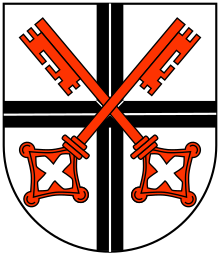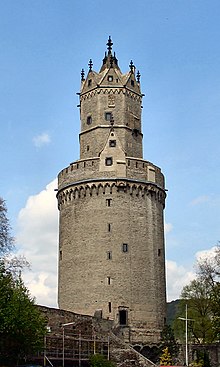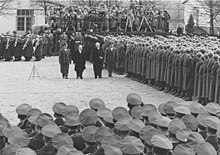History of the city of Andernach
This article gives an overview of the history of the city of Andernach .
Prehistory and early history
The settlement history of the Andernach area spans around 500,000 years. In the Miesenheim district (“Miesenheim I” site), animal bones and stone tools from the early Paleolithic , almost 600,000 years old, were found. They were researched in Monrepos . At the end of the last glacial period , around 15,000 years ago, people settled again. Andernach and the Gönnersdorf on the other side of the Rhine are among the most important sites of this time (see also Venus figurines from Andernach ). They are explored by Monrepos. The most important finds from this period are a bird carved from the discarded stick of a reindeer , depictions of animals and people on slate, and ivory statuettes of women .
From the Neolithic Age , i.e. from around 5000 BC. There are traces of the band ceramicists , the Michelsberg culture and the Rhenish cup culture . At the time of the urn field culture from around 1300 BC. A relatively dense settlement can be proven for the entire Neuwied basin.
The urn field culture was replaced by the Iron Age Hunsrück-Eifel culture , which began in 600 BC. Until 250 BC Lasted. The younger section is attributed to the La Tène culture , whose bearers were the Celts . In the center of the old town, at the latest from the 3rd century BC. A settlement of the La Tène period can be proven.
Roman times
Andernach is one of the oldest Roman settlements in Germany. Already in Gallic Wars was Julius Caesar 55 v. Near Andernach between today's Weißenthurm and Neuwied build a bridge over the Rhine in just ten days . 53 BC He repeated this achievement above Urmitz. The settlement of Antunnacum is a pre-Roman foundation. In the late Augustan / Tiberian period (from around 20 AD) a Roman fort was built there. A Raetian cohort was temporarily stationed in the fort (copy of the Firmus tombstone in the city museum). After the Batavian Uprising , Emperor Titus Flavius Domitianus began building the Limes , which created peace for two centuries. The result was an open settlement with a port in which millstones made of basalt and tuff stones from the stone pits near Mayen and Pellenz were loaded. Around 260 the Franks broke through the Limes, which forced the Romans to surrender the right bank of the Rhine. It now became necessary to fortify the previously open cities on the Rhine. However, there were repeated German invasions, which also destroyed Andernach. In 359 the city was fortified for the last time by the Roman Emperor Julian . At that time the fort had four gates and 14 round towers, one between the west gate (Kölner Tor, on today's Hochstraße) and the Rhine in front of today's round tower , four more on the west side south of the west gate including a corner tower, and two on the south side up to to the south gate (southern Kirchstrasse), six more towers to the east gate (Hochstrasse / Schaarstrasse) along the southeast wall and another tower between the east gate and the Rhine. The north side had no towers next to the north gate (northern Kirchstrasse). In the notitia dignitatum Andernach is referred to as a fort in which a department of the legio Acincensis was stationed. In 395 Stilicho was able to secure the full length of the Rhine border again, but then had to withdraw the legions to protect Italy . The Rhenish areas were left to the Franks , who were undisputedly the new masters with the victory of the Frankish king Clovis I over the last Roman army master Syagrius in 486 at the latest .
middle Ages
At the time of the Merovingians , Andernach initially belonged to Austrasia and became a royal seat. Venantius Fortunatus , who lived in Metz at the court of King Sigibert I , reports in his poem De navigio suo ("About his ship's journey") from the year 588 of a trip down the Moselle to Andernach and Leutesdorf with the young Merovingian king Childebert II. (570-595). The royal castle (lat. Villa regia ) is likely to have been located on the site of the Roman commandant's office (on Merowingerplatz between the Roman north and east gates) (until 2008 the Weissheimer company site ). King Dagobert I often stayed in the Andernach residence. In 859 the kings Karl II. The Bald , Ludwig II. The German and Lothar II. Met on the Rhine island "Krumme Werth" - today peninsula - Namedyer Werth to discuss a bigger meeting. After Austrasia and Neustria were united under the Carolingians , Andernach became one of the royal palaces . In the Treaty of Meersen , Andernach fell to Ludwig II the German in 870 and thus became part of the emerging German Empire.
After Ludwig's death in 876, Charles II. The Bald , the ruler of the western empire, asked Ludwig III. the surrender of the areas on the left bank of the Rhine and began with the military conquest. In the same year there was a battle between Andernach and Kettig ( First Battle of Andernach ), in which Charlemagne was defeated and Andernach's affiliation with the Eastern Empire was secured, from which the Holy Roman Empire developed.
In the years 882 and 883, the city was sacked three times during the Viking raids in the Rhineland . The Normans also raided the suburbium as well as the monasteries and churches outside the city - including the 7th century St. Stephen's Abbey . This also ended the longstanding trade relationship with Haithabu that had existed since 866 .
Duke Giselbert of Lorraine and Duke Eberhard of Franconia , the leaders of the great uprising against King Otto I , lost battle and life to the Conradin supporters of Otto I, Konrad Kurzbold and Udo, on October 2, 939 near Andernach ( Second Battle of Andernach ).
In the following centuries Andernach came into conflict between the two ore monasteries Cologne and Trier , both of which tried to get the imperial city under their rule. In the course of the clashes in 1114, among other things, the old royal court was destroyed.
On August 1, 1167, the Archbishopric of Cologne was able to prevail. Out of gratitude for the victory at Tusculum , Emperor Friedrich I gave the glory and the imperial court of Andernach with coinage and customs rights to his imperial chancellor and archbishop of Cologne Rainald von Dassel . Immediately after the donation, Rheineck Castle , which was in the Andernach area and was destroyed, was rebuilt by the Archbishopric of Cologne to secure the donation and to prevent the Count Palatine from accessing the castle again near the Rhine . For the management of the castle, the Cologne-proclaimed prince archbishops initially not entitled to inherit viscount .
With the takeover of power in the Andernach area, the city immediately got into the dispute over the German royal throne between Otto IV from the house of the Guelphs and Philip from the house of the Staufers , who conquered the city in 1198 and set it on fire. The old town church was also destroyed up to the current bell tower. 1194 had Emperor Heinrich VI. it was given to Archbishop Johann I of Trier , which prompted him to build a larger new bishop's church (1198–1220). Andernach belonged secularly to the Archbishopric of Cologne , but was subject to the spiritual jurisdiction of the Archbishop of Trier .
In the following years the city grew steadily, so that the Roman city walls were partly laid down and the city was expanded to the east. At the southeast corner, the castle of the Cologne sovereign was attached to the city wall as a separate defensive unit. It had its own gate to the outside (southeast corner, opposite Salierstrasse) and one to the city (Hochstrasse). The complete medieval fortification secured the city with five double gates - Kölnpforte (Coellenporzen) in the west, Kirchpforte (Kirchporzen) in the south, Schafpforte (Schafporzen) in the south, Burgpforte (Burgporzen, Koblenzer Tor, with drawbridge) in the east and Kornpforte (Korenporzen, Rheintor) ) in the north as main gates and five smaller gates, from east to west: Schreiberspforte, Moerspforte, Neupforte (east of the Kornpforte), Fischpforte, Trierpforte (near the round tower ) in the Rhine wall with neighboring defense core - as well as with 15 towers: keep, powder tower - Both belong to the castle, 10 semicircular wall towers (four on the west wall, six on the south wall), customs tower (northeast corner), citizen tower (rectangular wall tower on the east wall), round tower (main and guard tower of the city wall since 1453 on the northwest corner), as well as a 30 meter wide and 5 meter deep trench on the land side from the customs tower to behind the Cologne Gate. The church gate had its own, two-legged entrance ( Ravelin ) and was built as a double gate with two gatehouses, the rear one in the line of the wall, the front one directly on the moat in front of the wall with a bridge - both connected with a double wall. The Kornpforte also had two gatehouses, one behind the line of the wall and a second, as a huge, built-on porch with side porches (porches) to the east, parallel to the wall and to the west. Access to the city also ran through this, as can be clearly seen in an engraving by Matthäus Merian from 1646. The Vorwerk itself ended directly on the banks of the Rhine, which at that time ran near the city wall, so that access from the north was not possible. The bank in front of the wall served as a harbor up to the crane . The area on the Rhine in particular has undergone major changes over time. During this time hosted Andernach several monasteries, next to the Minoritenkloster near the castle, the provost of the Benedictine - monastery Malmedy - Stavelot with monastery church near the Schaar road emerged from the Merovingian royal court, and later the Annunziatenkloster since 1652 in the east of the city near the present museum. Outside there were St. Thomas in the southeast of the city and on the Martinsberg St. Martin.
Until 1349 there was evidence of a Jewish community in the city, whose residential area is presumably to be located south of the market square, west of Schafbachstrasse and mostly between today's Eisen- and Kramgasse towards the market. A semicircular tower that no longer exists in the southern city wall between the church gate and the sheep gate was called the Judenturm. Their synagogue was facing Eisengasse, south of the area of the historic town hall (today's foyer) with a Jewish bath (mikveh, see below) and a large bakery. As a result of the Jewish pogroms , triggered by the great plague epidemic , which spread from southern Italy to almost all of Europe in 1347, the Jewish community was driven out of the city in 1349. At the end of the 14th century (1381) a second Jewish community is known. Since the first synagogue and land had passed into Christian hands, the new congregation had no documented synagogue building, but presumably celebrated their meetings in a residential building. Around the middle of the 15th century, the second Jewish community had to leave the city. Although a few Jews lived in the city, a third Jewish community was only able to establish itself elsewhere in the city in the 19th century after 1860.
At the same time, the differences between the sovereign and the allied cities of Andernach, Bonn , Koblenz and Cologne intensified . When the Andernacher stormed the castle and tore it down without consulting the allies, they held back and Andernach was conquered by the sovereign's troops in 1367. Previously, the lucrative customs duty was already in place in 1365 by Prince Archbishop Engelbert III. (consisting of the home Mark came) from Andernach to Linz been laid. During this time the city got into debt, which among others helped the family of the money dealer Reynette Bonenfant to fortune. In 1407, the city council of Andernach was first mentioned in a document. In the second half of the 15th century Andernach was involved in the Burgundian War (1474–1477). Dispute referred to in the well "Cologne Diocesan Feud" supported Andernach with about 150 riflemen to the Cologne cathedral chapter appointed erzstiftlichen administrator Hermann von Hessen (the 1480 self-archbishop of Cologne was) and Emperor Frederick III. from the House of Habsburg against the Prince Archbishop of Cologne Ruprecht (who came from the House of Rhine ) and Charles I the Bold , Duke of Burgundy, whom he called for help . When his troops from the city of Linz on the Rhine, which was allied with him, fired a cannon on the earth fortification built by the Andernachers at Kripp on February 16, 1475, the Julian Day, the powder magazine exploded and killed almost all Andernach riflemen. In recognition of the blood toll, the emperor moved the Rhine toll back to Andernach in the same year and donated an imperial altar in the Andernach Mariendom. Three coats of arms (von Andernach, Hermann IV of Hesse and Emperor Friedrich III) on the vault stones are still a reminder today.
Reformation time
In Andernach, too, the beginning of the 16th century was a troubled time in many respects. There were social tensions within the city administration. If the nobility had previously been predominant here, the bourgeoisie increasingly managed to gain influence in the following decades. In 1522 the guilds succeeded with the “Achterstuhl” (better known as the “Achter”), a permanent representation of their interests against the council.
The Anabaptists from the Netherlands caused social unrest in the city, so that the council took punitive action against them. In 1543 the Cologne Prince Archbishop Hermann V (who came from the House of Wied ) converted to Lutheranism, sent preachers to Andernach and asked the council to appoint them. After Hermann V's abdication in 1547, his successors took action against the Lutherans , who, however, managed to stay in the city. In 1573 Prince Archbishop Salentin (who came from the Isenburg family and also returned to the Isenburg family) transferred 1000 guilders to the council for the renewal of the Latin school mentioned in 1433 . The council justified its request with the wish to bring up the children "in the right Catholic religion". When the Cologne prince-archbishop Gebhard I (who came from the house of the Reichserbtruchsesse von Waldburg ) converted to Protestantism in 1582 , another threatening situation arose for the Old Believers. The council had the Cologne gate closed. Initially, however, there were no arguments with the archbishop, who was removed the following year and had to flee to the Netherlands before his successor Ernst (who came from the Wittelsbach family). As a result, however, during the Cologne War (1583–1588), also known as the Truchsessian War , the city was attacked by Dutch troops under the Brabant military leader Olivier van den Tempel . He had come to the Rhine on behalf of Gebhard from the Netherlands to fight his successor Ernst and to recruit soldiers in the southern part of the Archbishopric. The attack by means of a petard on the Kornpforte (Rheintor), which was partially destroyed in the process, failed due to the resistance of the Andernach citizens.
This raid and the earlier events of 1365 and 1475 became sources of the baker boy legend .
Andernach in the Thirty Years War
During the first 14 years of the Thirty Years War , Andernach was spared direct effects of the war. This changed when, on November 10, 1632, the Swedish general Wolf Heinrich von Baudissin demanded maintenance payments from the city for the Swedish army. When the city did not immediately promise to do so, Andernach was occupied and plundered on the night of November 16-17, 1632. When the Count of Isenburg bombarded the city in March 1633 , the Swedes destroyed the fortifications, set the city on fire and withdrew. When they tried to occupy the city again on December 15 of the same year, however, they were prevented from doing so by the city's citizens. The city was in danger one last time when, in 1646, the French marshal Turenne had the city bombarded for 5 days, but then gave up the siege because he encountered unexpected resistance.
Destruction of the city in 1689
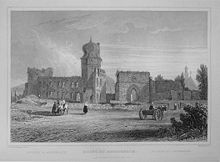
The Palatinate War of Succession (1688–1697) again put heavy loads on the city. In the struggle for the Archdiocese of Cologne, Ludwig XIV had Andernach occupied. As Elector Friedrich III. From Brandenburg approached the city only slowly from Bonn in 1689, the French troops looted the city, destroyed the electoral palace and razed all fortifications. Only the round tower withstood an attempt to blow it up. Only a huge hole reminds of this event today. On the night of April 30th to May 1st, 1689, the city was then set on fire after all extinguishing tools had been destroyed. Out of 400 houses only 74 were spared.
The following 18th century was initially marked by the slow reconstruction of the ruined city, with new garrisons and troop transfers during the War of the Spanish Succession ultimately leading to complete indebtedness and impoverishment of the city. The population fell well below 2000 (1790: 1790 inhabitants). At the end of the century there was a city in which economic development was hampered by medieval guilds and high tariffs. A general dissatisfaction with the prevailing conditions spread among the citizens of the city and prepared the breeding ground for the coming events - the French Revolution and its consequences.
French time
In the Treaty of Lunéville , Andernach fell to France on February 9, 1801, along with all areas on the left bank of the Rhine . Although this period only lasted until 1814, a complete upheaval in social and legal conditions took place during this time. The privileges of the nobility and the church were abolished, and the city's still largely medieval administrative structure was lifted.
This change was gradual, however. On October 22, 1794, Andernach was occupied by French troops. But when the Andernach patriots wanted to erect a tree of freedom on October 4, 1797 , this was prevented by the citizens. Many old officials of the French Republic also refused to take the oath of allegiance. The mayor appointed by the French even called for the nobility and the church to be reinstated in their properties. So behind a revolutionary facade the old order remained for the time being. This only changes fundamentally with the creation of the canton administration . Together with 18 surrounding communities, Andernach was merged to form the canton Andernach , with the city not having any special status as the canton capital.
With the administrative law of February 17, 1800, the Mairie Andernach was created, to which, in addition to Andernach, the communities Brohl, Eich, Miesenheim, Namedy and Nickenich belonged. With the secularization of the monasteries, monasteries and ecclesiastical bodies, the last remnants of the old class structure were also removed. In Andernach only the cathedral remained as a parish church. But when Russian troops occupied Andernach on the night of January 1, 1814, this was by no means perceived by all citizens as a liberation.
Prussian time
With the end of the Congress of Vienna , the city became a part of Prussia on April 5, 1815 . This initially had no consequences for the city's administration. In 1816, the cities in the Rhineland refused to adopt Stein's city order , as it fell behind the progress and freedoms achieved with the French order. Until the Prussian municipal code for the Rhine Province came into force in 1845, the French municipal administration remained essentially unchanged. On March 2, 1857, Andernach received the royal cabinet order as the third place (with 143 other cities in today's federal states of North Rhine-Westphalia , Rhineland-Palatinate, Hesse , Saarland and neighboring Belgium ) with the Rhenish town code of 1856 - Aachen received it on June 13, 1856 as the first town - again an independent town charter.
Economic development largely stagnated until the 1860s. In 1797 the Remy family moved the production of rolled sheet metal from Neuwied to Andernach in order to gain access to the French market. Production on the left bank of the Rhine was discontinued by 1841 at the latest. Other industries also migrated or disappeared when the benefits of linking up with France ended. All that was left was an efficient agriculture.
But the city was already expanding. In 1819 the city wall fell on the Rhine side. In the following years the gates to Mayen and Cologne disappeared. Between 1852 and 1854, the privately financed Mayen-Andernach-Neuwied Aktienstrasse was built . In 1858 Andernach received a station on the newly built Rhine Valley Railway . In the same year, with the decision of November 6, 1858, the then mayor of Andernach-Land and Andernach-Stadt, Ferdinand-Josef Weygold, parted administratively from Andernach-Land from the city of Andernach (continued by Heinrich Bynz as mayor). It was the hour of birth of today's association municipality Pellenz . From 1878 to 1880 the Andernach – Mayen railway line was built . There were further breakthroughs in the wall such as the laying down of the Wollgasse tower (one of the eleven semicircular wall towers, often referred to as the moat tower or incorrectly called the moat gate - there was no gate there -) or the gate-like breakthrough of the Ottenturm (semicircular wall tower near the castle, for a time called the goose gate ) .
Slowly new businesses settled in: in 1861 the Trasswerke Meurin, in 1864 the Weissheimer malthouse , and in 1865 the Wagner molding factory. At the end of the 19th century, the malt houses in particular developed into the most important industrial sector with 17 companies. However, these were basically labor-intensive industries with little productivity growth .
The 20th century
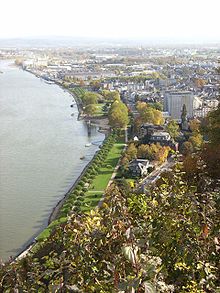
This development was then abruptly stopped by the First World War , the American and French occupation that lasted until 1929, by inflation and the global economic crisis , even though the Remy, van der Zypen & Co. steel strip mill started production in 1921 . The strongest party in the years between 1919 and March 1933 is the center . But the left-wing parties SPD and KPD also had a large number of voters. It was not until the elections in March 1933 that the National Socialists became the second largest party.
In 1933 the National Socialists seized power in Andernach. The new synagogue in Güntherstrasse was consecrated on May 30, 1933 , but it too burned to the ground during the pogrom night from November 9th to 10th, 1938. As far as they could not escape, the Andernach Jews were abducted and, with a few exceptions, murdered. In addition to the Jewish population, the patients in the sanatorium and nursing home suffered in particular . As an intermediate facility, this was the collection point for the southern part of the Rhine Province. From here the transports went to Hadamar or, after 1941, to the east, where the patients were gassed as "life unworthy of life" in the course of euthanasia . A euthanasia memorial behind the Christ Church - the "mirror container" - initiated by Andernach citizens in 1996 is a reminder of this.
During the Second World War over 500 men, women and children from Andernach lost their lives. The city itself was partially destroyed by air raids in late 1944 and early 1945 - but the old town center was largely spared. On March 9, 1945, American troops moved into Andernach. Large prison camps for up to 40,000 German soldiers were built on the Rhine meadows.
On July 10, 1945, the French took over Andernach from the Americans as part of their zone of occupation . From August 30, 1946, the city belonged to the state of Rhineland-Palatinate established by ordinance of the French occupying powers . In the first City Council election on October 25, 1946 Egon Herfeldt was candidate of the CDP - a precursor party of the CDU for - Mayor elected.
From 1949, what is now called the economic miracle began in Andernach . The silo towers of the Weissheimer malt factory grew next to the round tower . At the same time, the pumice industry flourished from the 1950s .
At the same time, the expellees from eastern Germany had to be integrated as new citizens. New building areas were opened up, completely new city districts emerged. New churches were built: St. Albert in 1954 , St. Peter in 1956 , Kreuzkirche in 1964 and St. Stephan in 1968 .
In December 1955, in the course of rearmament and the establishment of the Bundeswehr, the first 240 soldiers moved into the former air force hospital, followed by another 1000 in January 1956. The first official inspection of this first unit in the Krahnenberg barracks by the Federal Chancellor Konrad Adenauer took place on January 20, 1956 . The German radio station for members of the armed forces, which is highly valued, especially on missions abroad, is still called Radio Andernach today .
Between 1965 and 1970 a new harbor basin was built in the east of the city. In the course of the administrative reform in 1969/70, the city grew by 6500 inhabitants through the incorporation of the places Namedy (June 7, 1969), Eich, Kell and Miesenheim (November 7, 1970). On January 1, 1970, Andernach became a city belonging to the large district , in April 1970 the new Rhine port was inaugurated and handed over to its intended purpose. In 1978/79 the third to last malt house, Düsterwald and Tillmann, including the old town house, was demolished to make way for a department store building. In February 1998, the penultimate malt house, the Mengelbier company (founded in 1865) in Koblenzer Strasse opposite the sports field, followed the demolition, leaving the former malting town with 17 malt houses only one.
On January 1, 1970, the city of Andernach was declared a large district city by the state government at their request .
The 21st century
In 2001, the new youth center in Andernach opened, the new Hasenfänger primary school was inaugurated and, after long official negotiations, the world's highest cold water geyser (entry in the Guinness Book of Records ) on the Namedyer Werth was re-drilled to become a further landmark of Andernach for visitors to be accessible. In this context, a geyser information center was built on the Rhine . Andernach's landmark, the Round Tower , was 550 years old in 2003 and was given an extensive and extensive restoration with battlements repair and cleaning of the outer walls. It is open to visitors at certain times. In 2005–2007 the city museum, the more than 400-year-old von der Leyen house , also received a general renovation. In 2008 the Weissheimer silo towers fell victim to demolition as the last malt house (founded in 1864 as the city's first malt house) after 144 years of existence:
In the process, considerable finds (baths, harbor) from Roman times were discovered, thus providing archaeological evidence of the leading role of the Andernach harbor as early as Roman times in the first centuries AD.
Since January 20, 2009, Andernach has joined the group of places where “ Stolpersteine ” (memorial stones with inscribed brass caps) by Cologne artist Gunter Demnig keep alive the memory of Jewish citizens of Andernach who were deported during the Nazi era.
literature
- Christian von Stramberg , Anton Joseph Weidenbach : Memorable and useful Rheinischer Antiquarius , part 3, volume 4, Hergt, Coblenz 1857, p. 98 ff. ( Google Books )
- Peter Adams: Brief history of the city of Andernach . Andernach 1955
- Wolfgang P. Fischer: Search for traces 2000 - traces of Christianity in Andernach . Andernach 2000
- Franz-Josef Heyen (Ed.): 2000 years Andernach - history of a Rhenish town . City administration Andernach 1988
- Hans Hunder: Andernach. Depictions of the history of the city . Andernach city administration 1986
- Josef Schaefer: Andernacher Histörchen - stories of our hometown . Self-published, Andernach 1982, 2nd ext. Edition, experienced and told in Andernacher Platt.
- Dr. Klaus Schäfer (Ed.): Andernach Jews in the Middle Ages . Booklet accompanying the exhibition in the City Museum (October 6 - December 16, 1990)
- Gerhard Terwelp: Andernach at the time of the Thirty Years' War . Andernach 1887; digitized version
- Gerhard Terwelp: Contributions to the history of the city of Andernach . Andernach 1888; digitized version
Web links
Individual evidence
- ↑ Venantius Fortunatus, Carmen X 9 (ed. Friedrich Leo , MGH Auctores Antiquissimi 4.1, Berlin 1881, pp. 242–244 ), here verses 63–67 (ed. Leo p. 243). German translation and extensive commentary by Paul Dräger : Venantius Fortunatus' two Moselle trips (carmina 6.8 and 10.9). In: Kurtrierisches Jahrbuch, Volume 39, Trier 1999, pp. 67-88, here especially pp. 81 and 83-87.
- ^ Theodor Joseph Lacomblet : Document book for the history of the Lower Rhine , first volume, Düsseldorf 1840, p. 296, document 426 ( digital collections of the University of Bonn )
- ^ Theodor Joseph Lacomblet : Archive for the history of the Lower Rhine , Volume V, Düsseldorf 1866, p. 323. ( Google Books )
- ↑ State ordinance on the declaration of the cities of Andernach, Bingen and Lahnstein as a large city belonging to the district of December 9, 1969
